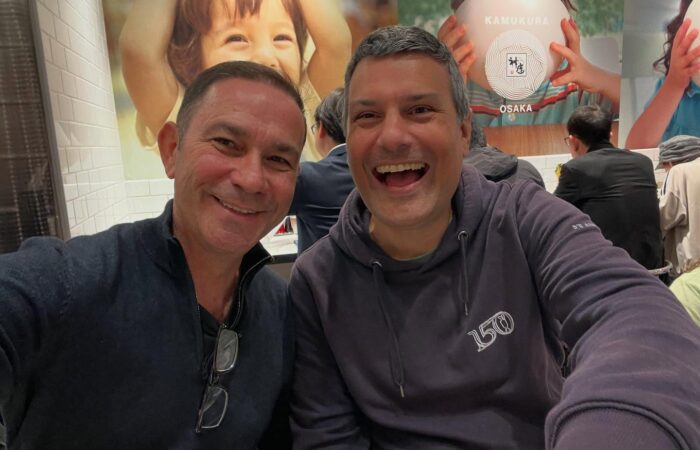Business Ownership Can Be Fun
DATELINE: BRISBANE, AUSTRALIA
Blackboard Fridays Episode #50 – The Most Colourful Business Strategy in the World
The milestone warrants a very special episode, and so that’s what we have created. It’s a little bit longer so grab a Friday morning coffee and perspective shift as we walk through all 12 elements of my Contextual Business Plan.
In the years since this video was filmed I have rebranded to Como Business Coaching, and this system has evolved as the business world changed through the Coronavirus Recession and beyond. This integrated management system remains relevant to businesses of all sizes, and being able to connect these different parts sets Como apart from others who can only contribute one piece of the puzzle.
- Strategic frameworks based on decades of research and application;
- All road-tested on privately held companies, active growth businesses, and SMEs around the world;
- If you’re feeling stuck, uncertain, or just don’t know what you don’t know in business, I guarantee 1 of these 12 elements is the cause.
Complete Article Below – Click Here to Read or Share at JacobAldridge. com
Welcome to Blackboard Fridays Episode 50! For this special landmark episode, we’re going to dive deeper into what we call our “Contextual Business Plan”, the integrated contextual approach that our clients apply in their businesses to empower their bright ideas.
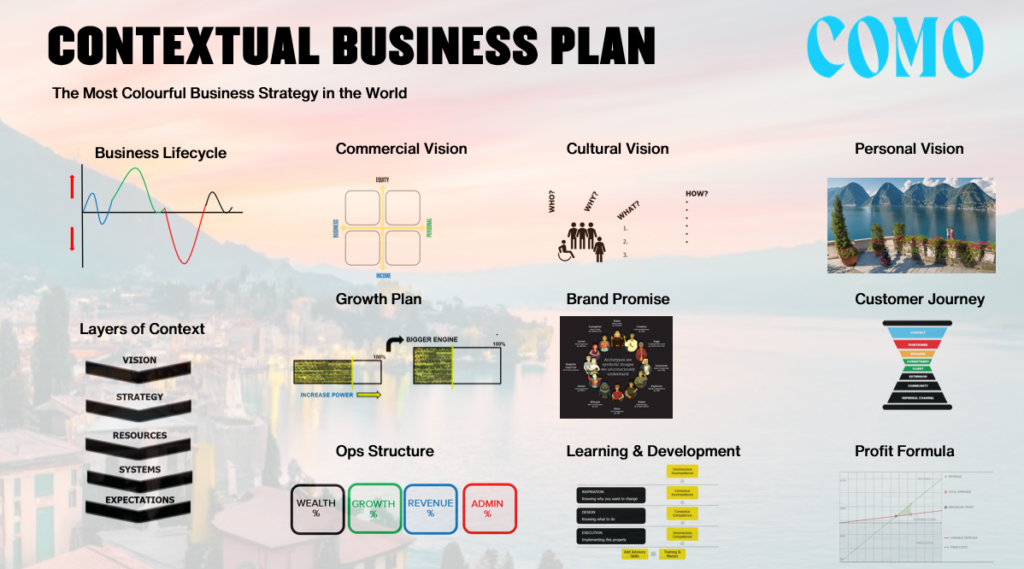
Not only is this a practical approach to business strategy, but the integrated consistency that we apply means that all of the key decisions that you need to make as a business owner are connected.
Blackboard Fridays as a video series, and the Como business coaching solution I bring to business owners is not a whole series of “more stuff” that you need to think about.
It’s one system that you can apply (as much or as little as you choose) to get real sustainable results.
Let’s jump into it.
The Business Lifecycle
It starts at the top here with The Business Lifecycle.
When you understand the Business Lifecycle and how is applies to your unique business journey, then you can place yourself on this diagram.
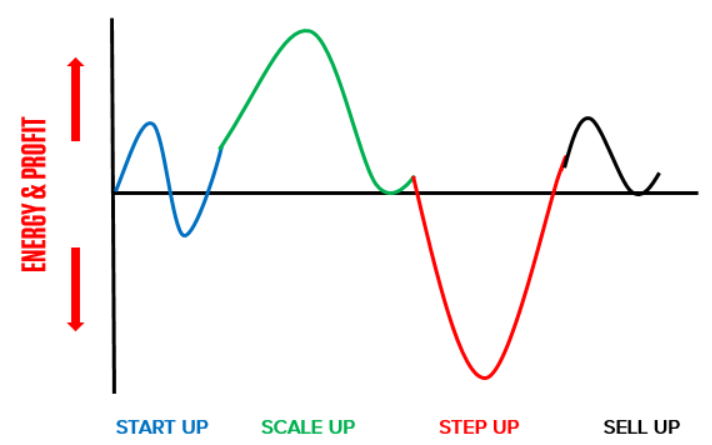
You can acknowledge where you’ve been. You know the hurdles and the brick walls that are coming up. And, importantly, you can recognize the feelings and the energy that is impacting you as a business owner and your team. That energy acknowledged and managed will impact all of the other decisions that you make.
The Layers of Context in the Contextual Business Plan
From the Business Lifecycle we move down to the Layers of Context.
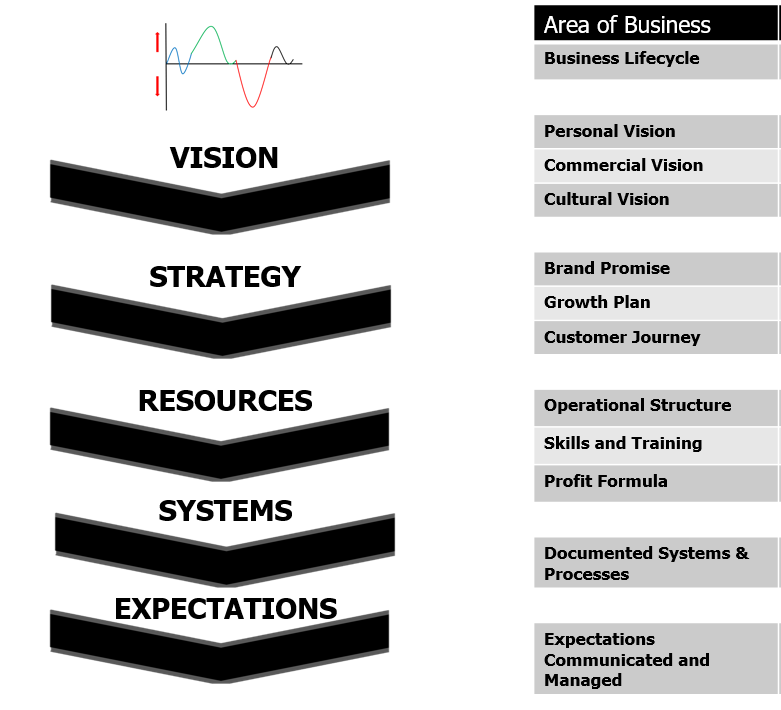
You may recall from one of my earliest videos the key conversation about starting at the top with Context. Your Vision for the business and how the Vision you have feeds into the Strategy, the Resources, Systems, Expectations and finally, manages the day-to-day “Stuff” that’s integral to your business.
Too many business owners (and frankly, too many other ‘business coaches’) just play around in the Stuff.
Jacob Aldridge, International Business Coach
The Como Contextual Business Plan is designed to pull you up to a higher perspective, to get you working on and not in the business. Every single one of the strategic frameworks we have is designed to make a contextual decision that you can then apply.
What do I mean by the contextual frameworks? Well let’s start moving through.
Vision: Commercial, Cultural, Personal
In business, the highest layer of Context is your Vision. And there are three elements of Vision:
- Your Commercial Vision
- Your Cultural Vision, and
- Your Personal Vision.
Commercial Vision is a conversation around the Income and Equity choices you want to create for your business.

Culture covers things like who are your ideal team members? Why are you in business? What are your core values? And critically, How do you live that?
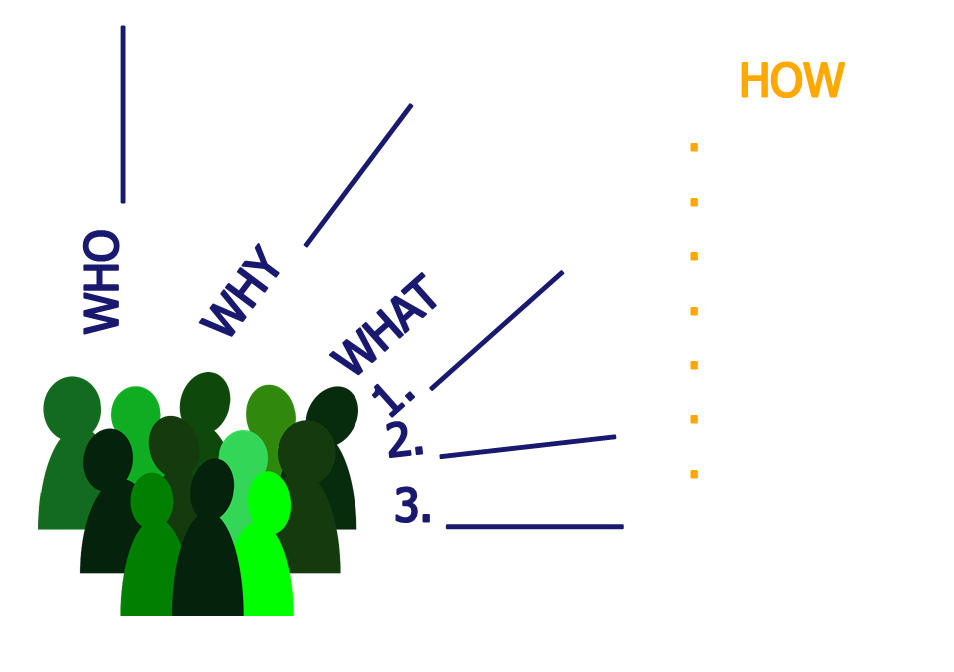
While this Business Plan is contextual, it is not designed to be fluffy. It’s designed to be practical so that you can implement How within your business. My two videos on Culture Rituals continue to attract positive comments, and are conversations and examples specifically about the How.
The Personal Vision is the conversation we have is around the Wealth Quadrant, particularly the Wealth Quadrant for business owners. How do you make sure that even as a business owner, you’re not playing in the Job Quadrant? How can you ensure you’re actually building wealth for you and your family, and from there creating freedom.
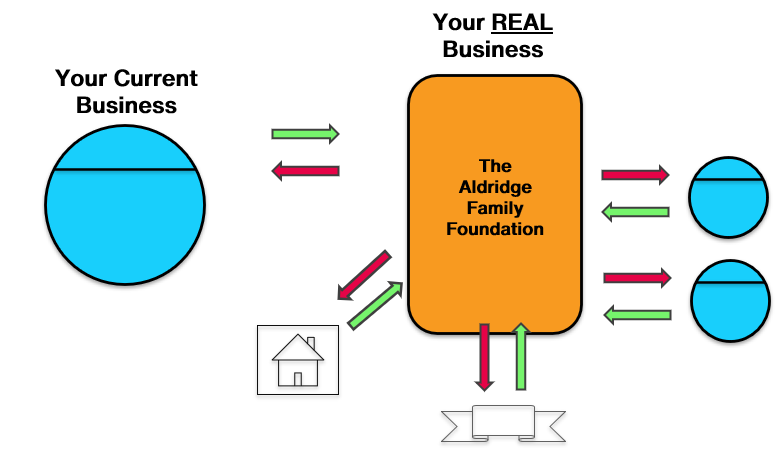
Beyond the impact your organisation has, and the amazing experience you and your team have when they come to work each day … What’s in it for you? What’s your number?
That’s a key part of your Vision.
The Strategy Layer of Context
Once you are clear on your Vision, you can then move down and make key Strategy decisions.
And as with Vision, there are three areas of Strategy within your business you need to make decisions and communicate.
- Your Capacity Growth Plan
- Your Brand Promise
- Your Customer Journey
Let’s look at Your Capacity Engine, the strategic framework we use to answer the question “What is Business Strategy?“. Right now, how big is your engine? What’s your utilization rate? Are you focused on being better and getting more power out of the current engine or being bigger, growing into a bigger engine?
This is why I love and recommend business planning at Context – of the million great ideas in your head right now, the only decision you need to make is “Do we need to focus on Be Better or Be Bigger?”. With that clarity of decision, you and your team can start jumping into specifics.
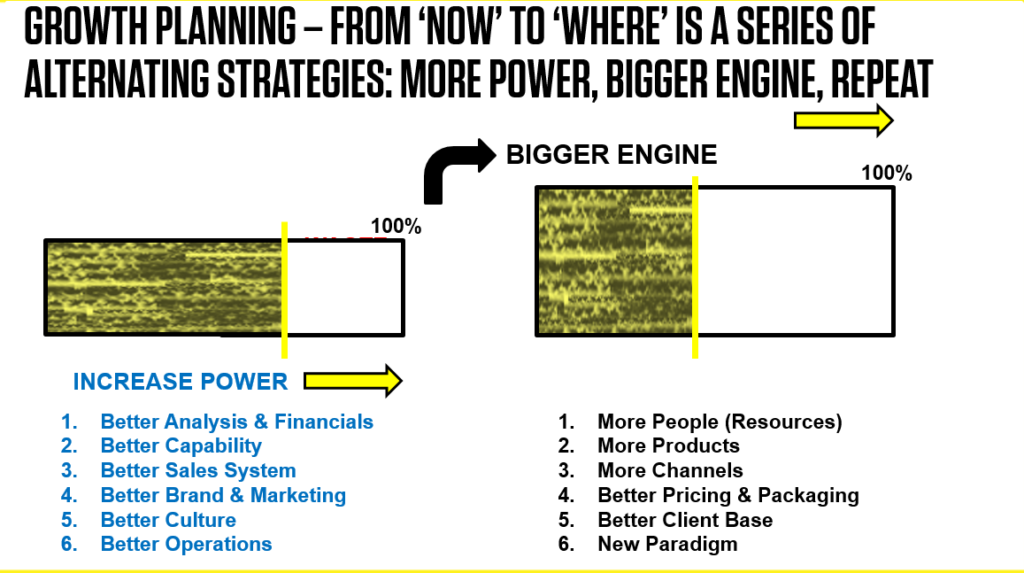
The next key part of strategy within a business is your Brand Promise.
Now, remember Brand is separate from branding from marketing. While those are important elements of your business, they stem from your Brand – which I like to describe as is “what you’re famous for”. Your Brand is how people describe your business when you’re not in the room.
What’s the strategic approach you’ve taken to determining which Brand Archetype your Brand stands for? How you and your team consistently delivering your Brand Promise?
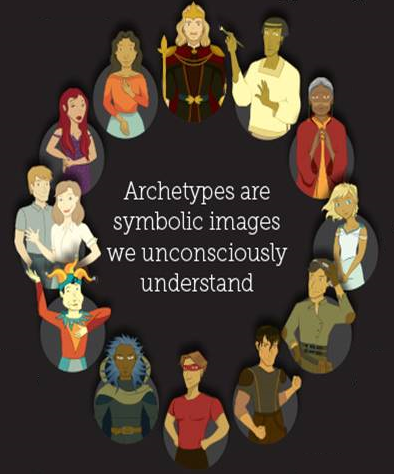
The third element of the Strategy Layer of Context is the Customer Journey, which overlaps with the Sales Hourglass that we’ve discussed in previous episodes of Blackboard Fridays.
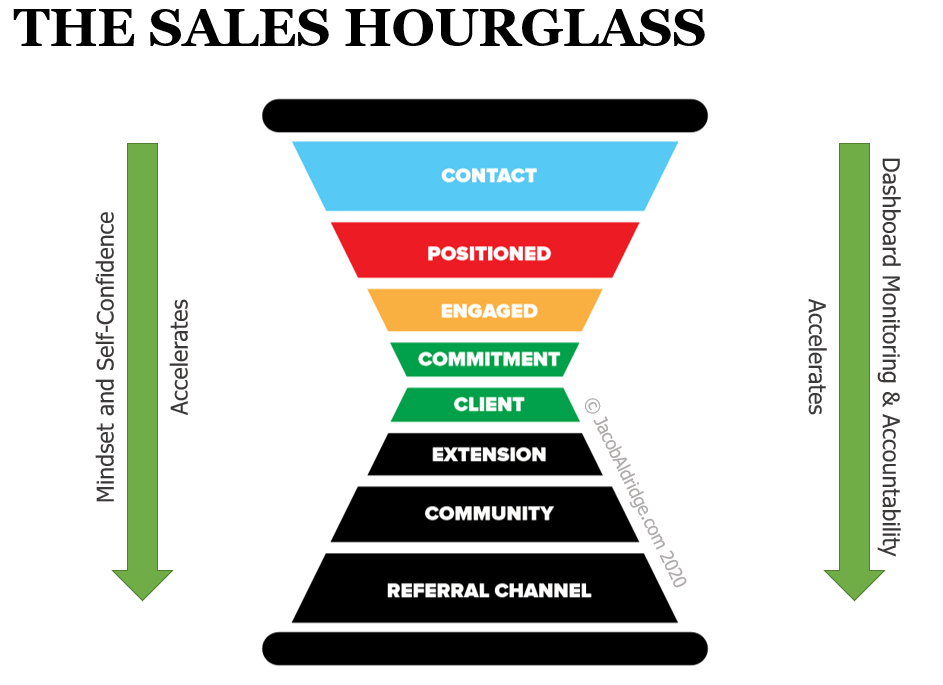
So far we have focused on you – your Vision, and the Strategic experience you want to create as you grow. Now we must think a little more customer-centric.
How is your customer finding you? What’s the journey that they to become a client of yours? How do you make them a client for life and ideally, a paying client for life? It all starts with understanding who your ideal client even is to take them on that journey.
So there are the three elements of Strategy: Capacity, Brand, and Customer. Once you’re clear on that, you can start moving the conversation into the Resources.
The Resources Layer of Context
The Resource layer within a business is where a lot of business owners start to feel they’re really getting bogged down.
What I want to do is make managing your resources – your people and your money – as simple as possible.
R&R stands for Roles & Responsibilities, but more importantly for you as a business owner, it means Rest & Recuperation. If you’ve got the right team around you, if you’re investing your time appropriately across these four areas–wealth, growth, revenue, and administration, then managing your business will be easier and you will have more time.
Over almost 20 years of coaching business owners who want freedom and flexibility, there’s a reason this Operations Management system is one of my most implemented changes – it really does add 20%+ more profit and give business owners back a full day every week.

A key part of your human resources is the Learning and Development aspect.
Not only do you need the right people doing the right jobs at the right time, you need them to have the right skills.
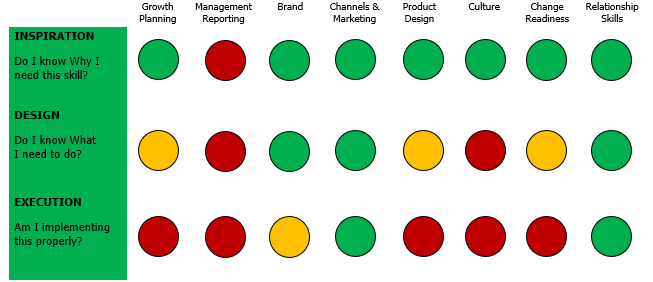
There’s the great “Culture” aphorism – and you start to see how these different layers of context are integrated – that if you hire the right people and train them for skills, you’re going to go much farther in business than if you hire for skills and ignore the culture. Culture sits above and informs the Learning and Development plan that you have, just as your Capacity Growth Plan (who to hire and when) sits above and informs your L&D needs.
Lastly on the Resources layer, money has to come into this. I wouldn’t be one of the Top 12 Business Coaches in the World if I wasn’t able to jump in and talking revenue, costs, and profit with my clients. You as a business owner can’t ignore those either.
So, what’s your Profit Formula?
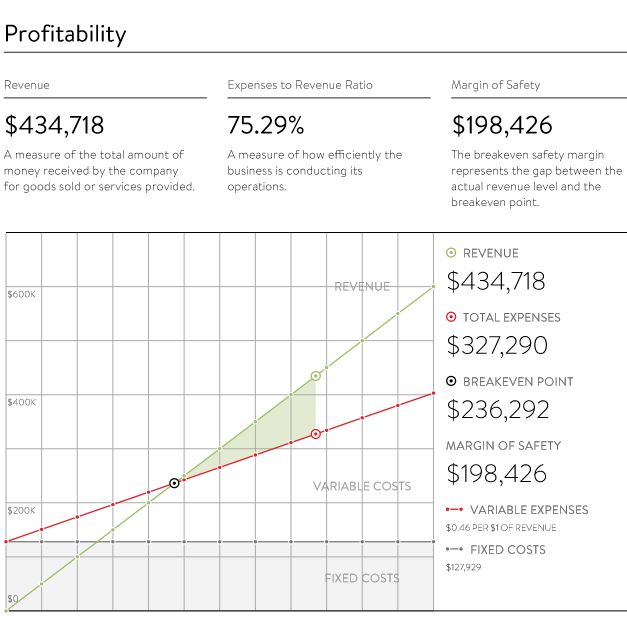
How do you break down your Profit? How well do you understand your numbers … not just as the diagram talks about, things like “Fixed Costs” and “Revenue”, but the numbers that make an enormous difference to your financial and mental health – like your Break-Even Point, your Cash Break-Even Point, and your Cash Flow?
If you can manage the money, that goes a long way to managing the energy of you and your team.
The Systems Layer of Context in Business Planning
These top 3 layers of context in the Contextual Business Plan are the three big areas: Strategy, which is informed by Vision, guiding the Resources.
Now we jump a little closer to the Content. Systems can be a long conversation with your business, and you want to do this right. While there is no magic template that will shortcut the systems, I will point out that too many business owners can go too far.
Over-documenting, over-complicating your business systems will move you away from your Vision not towards it, especially if you’re in the Start Up or Scale Up stage of your Business Lifecycle where you don’t need to go as deep into these as many other older, larger businesses.
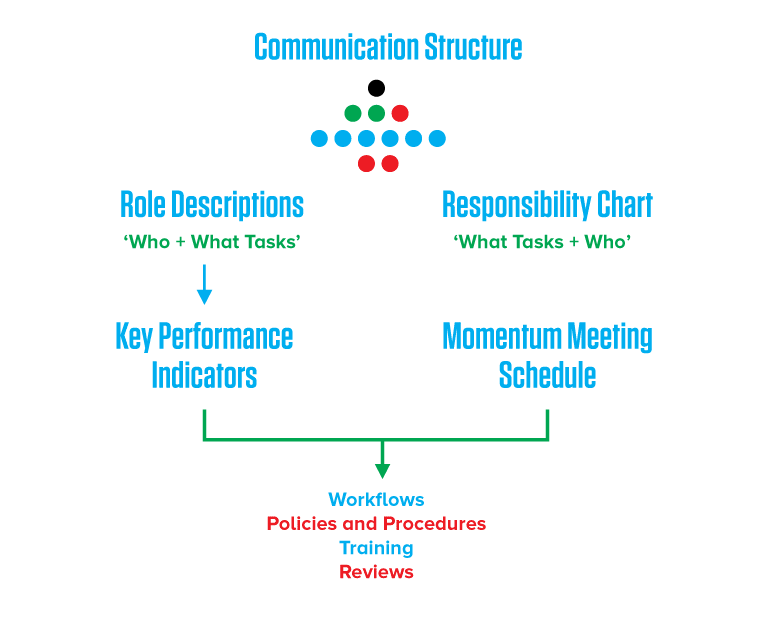
Here are some of the things that we’ve talked about these in Blackboard Fridays episodes. What are the roles and what are the responsibilities? The ideal week for your key team members? The momentum meeting schedule you’ve got to get communication flowing between the different areas of your business. That then feeds into workflows, documented policies and procedures, training, and reviews.
Getting all of that clear will often mean losing team members. I warn clients when we do this as a strategic project:
10% of your staff will leave. Great! Because that’s the 10% of your staff that no longer fit in the resource mix you need to implement the strategy and vision you’re building.
Jacob Aldridge, yes I quote myself a lot
Building better Systems that support your business future is a great way to shine a light on the people who maybe aren’t actually supporting your business for the future.
Expectations: For When You Have to Work Up, Not Down
Once you’re clear on the Systems that are documented, and they have been communicated, the last Layer of Context is Expectations. Expectations for your team, for your customers, and for yourself and your family.
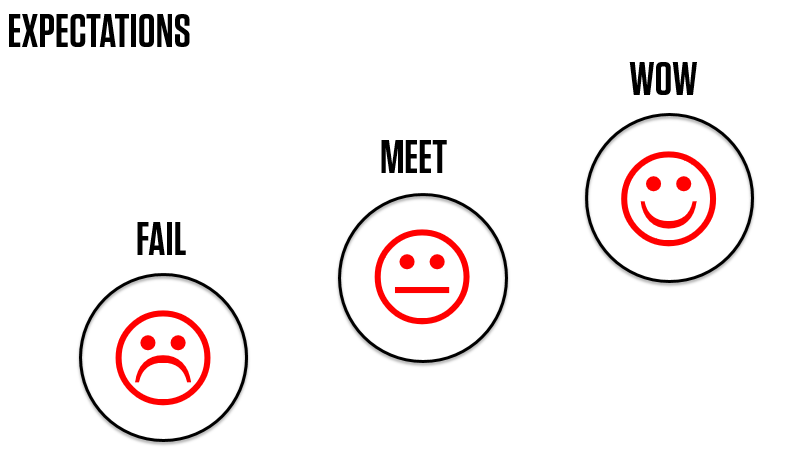
Where’s the energy within your business:
- Are you Meeting Expectations, you’re kind of feeling okay?
- Are you Failing on your Expectations and feeling down around your business?
- Or, Ideally, are you exceeding the right Expectations and creating the Wow?
This is what the Contextual Business Plan manages to achieve for businesses – to create the wow for the business owner, and from the business owner their team all the way down.
I once heard business ownership described as “Needing to be an Astrophysicist and a Microbiologist” – you need to be capable of jumping to the big picture, the highest Layers of Context, and you also need to be able to jump into the details, the day-to-day stuff.
If you and your business are completely stuck in the stuff, jumping to Vision and Strategy may be a step too far – too high a Context to help. In these cases you must work from the bottom-up, and that means addressing the Expectations mis-match that I guarantee is holding you back.
The Most Colourful Business Strategy in the World
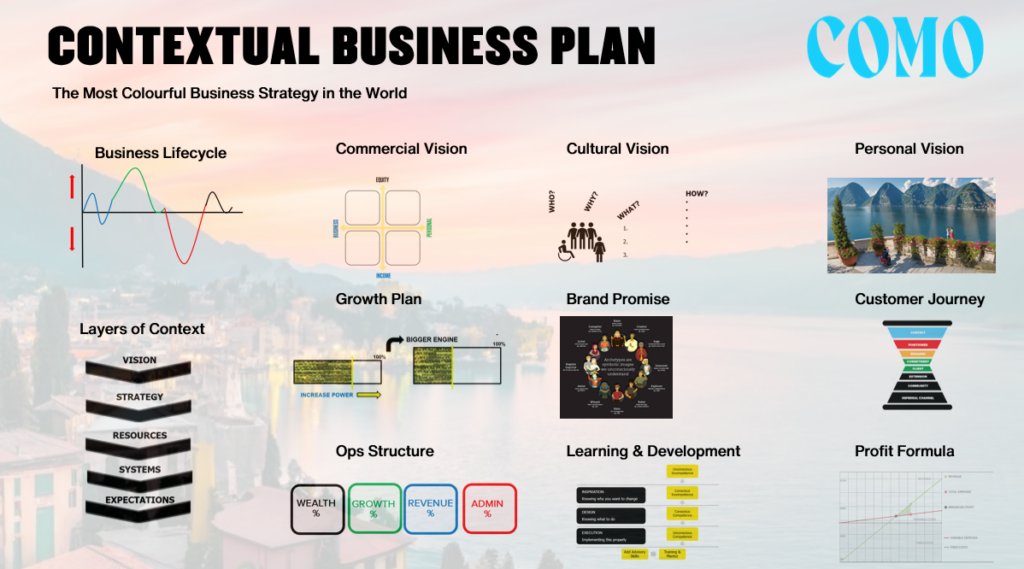
This is the most colourful business strategy you will ever see, and the colour is deliberate.
This Contextual Business Plan is designed to help you make key decisions, communicate them into your team, and then and fully and practically implement your best ideas.
It’s not rocket science. It’s 12 key questions that you as a business owner need to answer. Answer those for your business today, and recognize that as your business grows and develops you get to have the discussions again, you get to make different choices.
Thank you so much for your support across 50 episodes of Blackboard Fridays. There’s always more stuff in business but don’t let the stuff hold you back from making your choices, climbing your mountains, and taking your bright ideas and turning them into reality.
Next Steps
Want to learn more about how this can apply to your business? It costs nothing for us to chat:
- Email me jacob@jacobaldridge.com
- Call, Text, or WhatsApp me +61 427 151 181
With love,
Jacob Aldridge
International Business Advisor
Visit my website
Connect on LinkedIn





